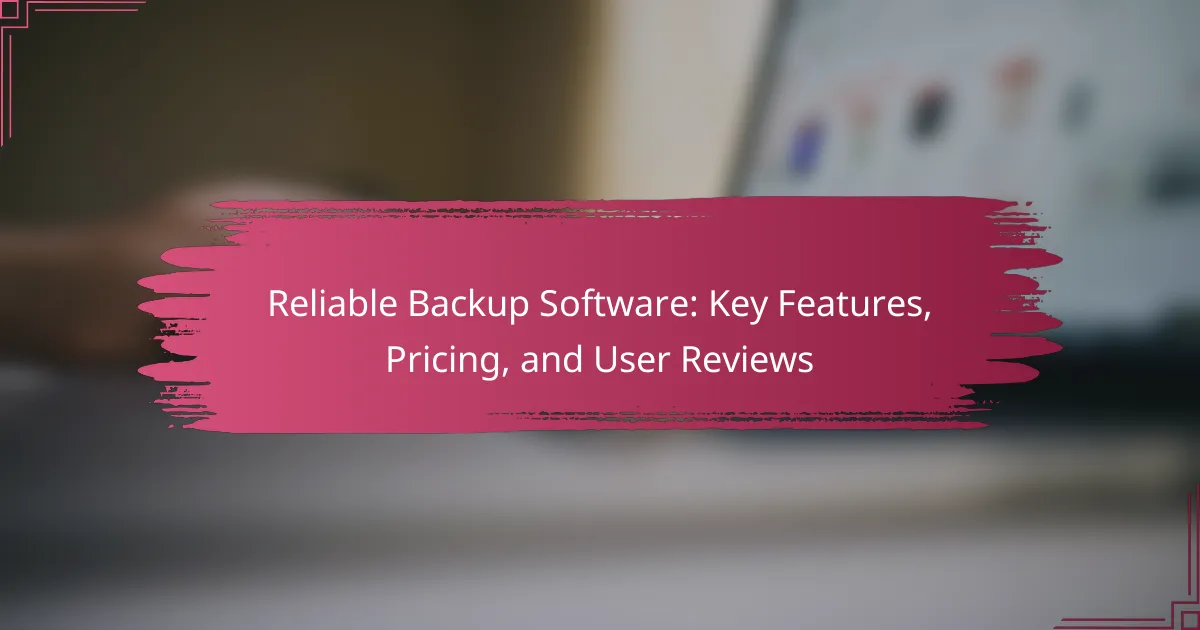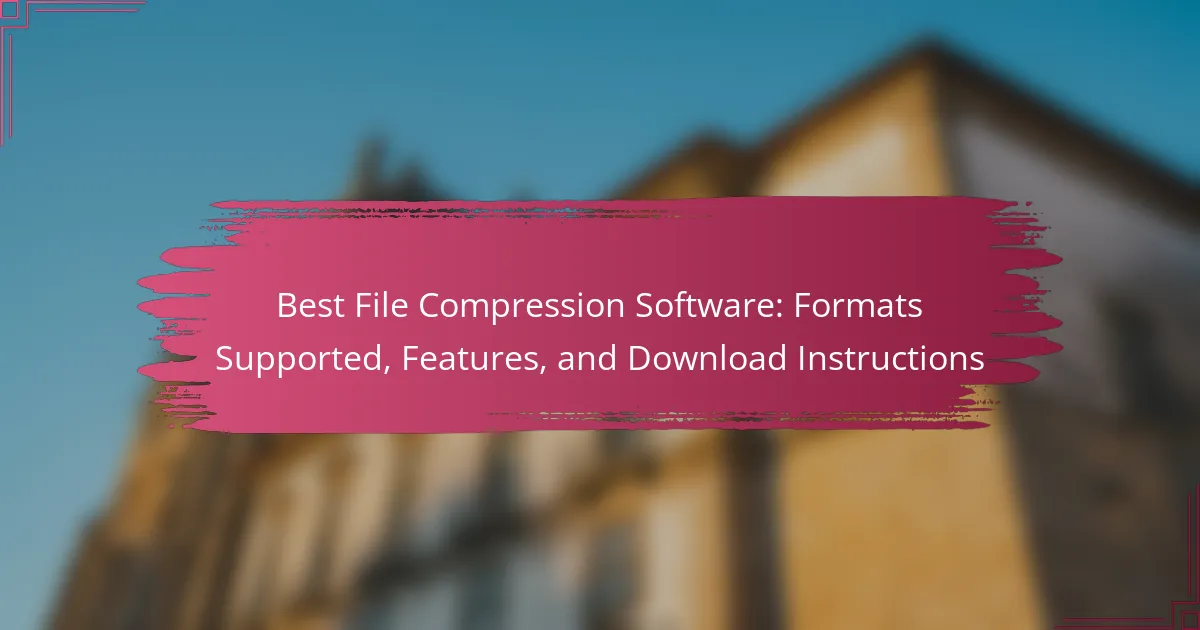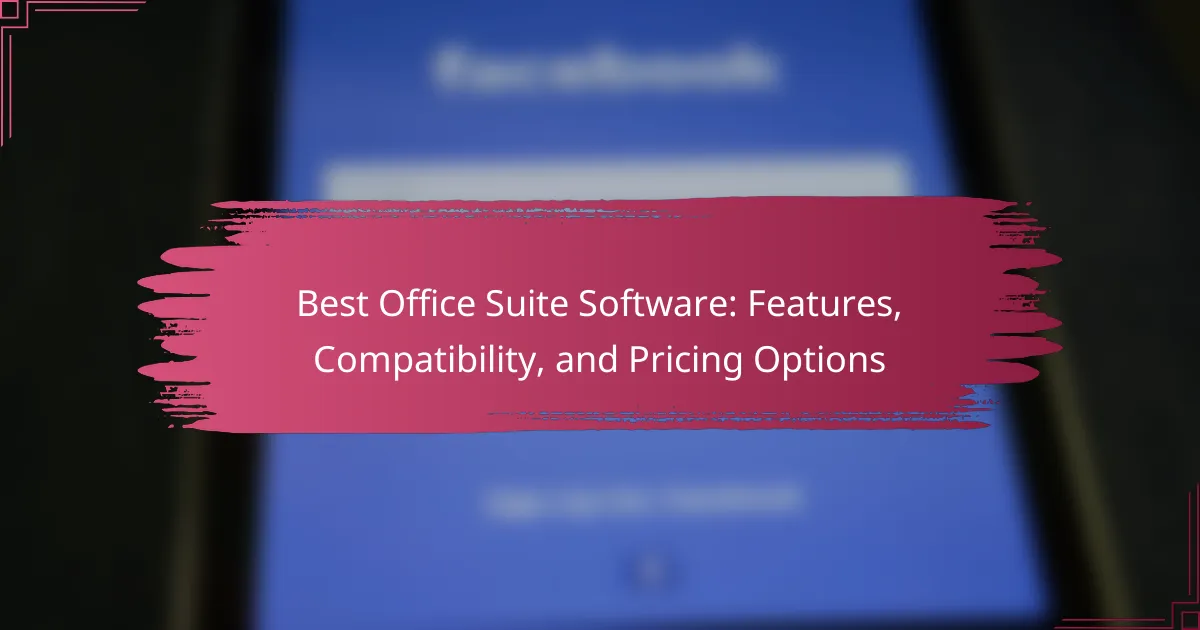The article focuses on top video editing software, specifically Adobe Premiere Pro, Final Cut Pro, DaVinci Resolve, Filmora, and Sony Vegas Pro. It outlines the key features of each software, such as Adobe Premiere Pro’s advanced color grading tools, Final Cut Pro’s magnetic timeline, DaVinci Resolve’s professional audio editing capabilities, and Filmora’s user-friendly design for beginners. Additionally, the article discusses system requirements and pricing for each option, providing insights into their unique strengths tailored to various user needs. It also offers practical tips for enhancing the video editing experience, including workflow optimization, organization of media files, and the importance of software updates.

What are the top video editing software options available today?
The top video editing software options available today include Adobe Premiere Pro, Final Cut Pro, DaVinci Resolve, and Filmora. Adobe Premiere Pro is widely used for its comprehensive features and integration with other Adobe products. Final Cut Pro is favored by Mac users for its user-friendly interface and powerful editing capabilities. DaVinci Resolve offers advanced color correction tools and is popular for professional-grade editing. Filmora is known for its simplicity and accessibility for beginners. Each of these software options has unique strengths that cater to different user needs in video editing.
How do different video editing software compare in terms of features?
Different video editing software varies significantly in features. Popular options include Adobe Premiere Pro, Final Cut Pro, and DaVinci Resolve. Adobe Premiere Pro offers advanced editing tools and integration with Adobe Creative Cloud. It supports multiple formats and provides powerful effects and transitions. Final Cut Pro is optimized for Mac users and features magnetic timeline and advanced color grading. DaVinci Resolve excels in color correction and audio post-production. Each software has unique strengths catering to different user needs. For example, Premiere Pro is favored for collaborative projects, while Final Cut Pro is preferred for fast-paced editing.
What key features should you look for in video editing software?
Key features to look for in video editing software include user-friendly interface, multi-format support, and robust editing tools. A user-friendly interface allows for efficient navigation and editing. Multi-format support ensures compatibility with various video file types. Robust editing tools include features like trimming, cutting, transitions, and effects. Additionally, consider features like audio editing capabilities and color correction tools. Collaboration tools can enhance teamwork on projects. Regular updates and customer support are also essential for ongoing usability. These features collectively enhance the editing experience and improve productivity.
Which software offers the best user interface and experience?
Adobe Premiere Pro offers the best user interface and experience among video editing software. Its interface is customizable, allowing users to arrange panels according to their workflow. Adobe Premiere Pro supports various formats, enhancing flexibility for different projects. The software includes intuitive tools for editing, color correction, and audio mixing. User feedback highlights its efficiency and smooth performance. Additionally, Premiere Pro integrates well with other Adobe products, creating a seamless experience for users. Its consistent updates ensure that it remains user-friendly and up-to-date with industry standards.
What are the system requirements for popular video editing software?
System requirements for popular video editing software vary by application. For Adobe Premiere Pro, a Windows 10 or later OS is required. It needs an Intel 6th Gen or newer CPU. A minimum of 8 GB RAM is necessary, with 16 GB recommended. The software requires 2 GB of GPU VRAM for optimal performance. For Final Cut Pro, a macOS 10.15.6 or later is essential. It requires 4 GB of RAM, with 8 GB recommended. The software needs a Metal-capable graphics card. DaVinci Resolve requires a minimum of 16 GB RAM, with 32 GB recommended for larger projects. It also needs a compatible GPU with at least 2 GB VRAM. These specifications ensure smooth operation and efficient editing workflows.
How do hardware specifications impact video editing performance?
Hardware specifications significantly impact video editing performance. The CPU determines processing speed and multitasking capabilities. A higher clock speed and more cores enhance rendering times and playback smoothness. The GPU accelerates rendering and effects processing, improving real-time playback. Sufficient RAM allows for handling large files and multitasking without lag. Storage type also matters; SSDs provide faster load times than HDDs. For example, an SSD can reduce project load times by up to 70%. These specifications collectively ensure efficient editing workflows and minimize delays.
What operating systems are compatible with leading video editing software?
Leading video editing software is compatible with various operating systems. Commonly supported operating systems include Windows and macOS. Some software may also offer compatibility with Linux. For instance, Adobe Premiere Pro and Final Cut Pro are popular on Windows and macOS, respectively. DaVinci Resolve is available on Windows, macOS, and Linux. Compatibility may vary based on software updates and versions. Always check the specific system requirements for each video editing application.
What pricing models are available for video editing software?
Video editing software typically offers several pricing models. These models include subscription-based pricing, where users pay a monthly or annual fee for access. Another model is one-time purchase pricing, allowing users to buy the software outright without ongoing fees. Some software may also offer a freemium model, providing basic features for free while charging for advanced tools. Additionally, there are tiered pricing models that offer different levels of features at varying price points. These pricing structures cater to different user needs and budgets.
How do subscription-based and one-time purchase models differ?
Subscription-based models require ongoing payments for continued access to software. Users pay a regular fee, often monthly or annually. This model typically includes updates and support as part of the package. One-time purchase models involve a single upfront payment for permanent software access. Users own the software indefinitely but may need to pay for future updates.
According to a 2023 industry report, subscription models are increasingly popular due to lower initial costs and access to the latest features. In contrast, one-time purchases appeal to users who prefer a single payment without recurring fees. This distinction impacts budget planning and software usage over time.
What factors influence the pricing of video editing software?
The pricing of video editing software is influenced by several key factors. These factors include software features, user interface design, and customer support options. Advanced features such as 4K editing and motion graphics capabilities often lead to higher prices. The complexity of the user interface can also affect pricing, as more intuitive designs may command a premium. Additionally, ongoing customer support and updates can contribute to the overall cost. Market competition plays a significant role as well, with software developers adjusting prices based on competitors’ offerings. Licensing models, such as subscription versus one-time purchase, further impact pricing structures. Lastly, target audience and market demand can lead to variations in price, with professional-grade software typically priced higher than consumer-level options.
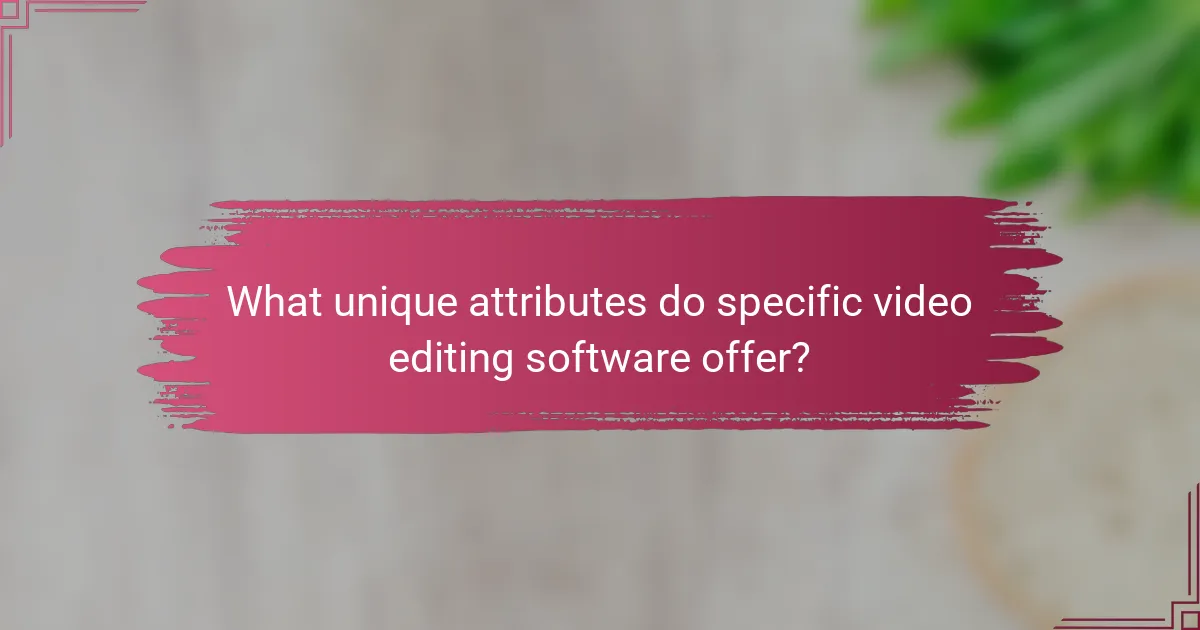
What unique attributes do specific video editing software offer?
Adobe Premiere Pro offers advanced color grading tools. These tools allow users to manipulate colors with precision. Final Cut Pro features a magnetic timeline. This timeline simplifies the editing process by automatically adjusting clips. DaVinci Resolve provides professional-grade audio editing capabilities. These capabilities enhance the overall sound quality of video projects. Sony Vegas Pro includes robust motion tracking features. This allows for easy integration of effects with moving objects. Each software has unique attributes that cater to different editing needs.
How does the software’s target audience affect its features?
The software’s target audience directly influences its features. Different audiences have varying needs and preferences. For instance, professional editors require advanced tools like multi-track editing and color grading. In contrast, beginners may benefit from user-friendly interfaces and basic editing options.
Market research shows that 70% of users prioritize ease of use in consumer-grade software. This drives developers to simplify workflows and include tutorials. Conversely, professionals seek robust performance and customization, prompting the inclusion of plugins and high-resolution export options.
The audience’s demographics, such as age and experience level, shape feature sets significantly. For example, younger audiences often prefer mobile compatibility and social media sharing capabilities. Thus, understanding the target audience allows software developers to tailor features effectively, ensuring user satisfaction and engagement.
What are the unique selling points of software aimed at professionals?
Unique selling points of software aimed at professionals include advanced features, customization options, and robust support. Advanced features often encompass high-resolution editing, multi-track timelines, and specialized tools for color grading. Customization options allow users to tailor the interface and workflows to their specific needs. Robust support typically includes dedicated customer service, extensive documentation, and community forums for troubleshooting. These aspects enhance productivity and efficiency, making the software more valuable for professional use. For instance, Adobe Premiere Pro offers industry-standard tools that cater to filmmakers and video editors, reinforcing its position as a leading choice in the market.
How does consumer-focused software differ in functionality?
Consumer-focused software typically emphasizes user-friendliness and accessibility. This software often includes intuitive interfaces designed for non-technical users. Features commonly prioritize ease of use over advanced capabilities. For instance, drag-and-drop functionality is prevalent in consumer-focused video editing software. Additionally, these applications frequently offer pre-set templates and automated tools. This contrasts with professional software, which may require extensive training. According to a 2021 survey by Statista, 70% of users prefer software that simplifies complex tasks. Thus, the functionality of consumer-focused software is tailored to enhance user experience and streamline processes.
What are the rare features that some video editing software provide?
Some video editing software provide rare features like AI-driven editing tools. These tools automate complex tasks, saving time for users. Another rare feature is 3D editing capabilities, allowing for advanced visual effects. Some software includes multi-camera editing for simultaneous footage from various angles. Unique color grading tools can create specific cinematic looks not commonly found. Collaborative editing in real-time is also a rare feature, enabling multiple users to work on a project simultaneously. Additionally, certain software offers integration with VR content creation, which is uncommon in standard video editing tools. These features enhance the editing process and expand creative possibilities for users.
Which software includes advanced effects and transitions?
Adobe Premiere Pro includes advanced effects and transitions. It offers a wide range of customizable effects, including color grading and motion graphics. Final Cut Pro also provides advanced transitions and visual effects. DaVinci Resolve is known for its powerful color correction tools and dynamic transitions. These software options are widely used in the industry for their comprehensive feature sets.
How do collaboration features enhance the editing process?
Collaboration features enhance the editing process by allowing multiple users to work simultaneously on a project. This real-time interaction fosters creativity and speeds up decision-making. Editors can share feedback instantly, reducing the time spent on revisions. Tools like comment threads and version history help track changes and maintain clarity. Studies show that collaborative editing increases overall productivity by up to 30%. Furthermore, cloud-based platforms enable access from anywhere, facilitating remote teamwork. These features ultimately lead to a more efficient and dynamic editing workflow.
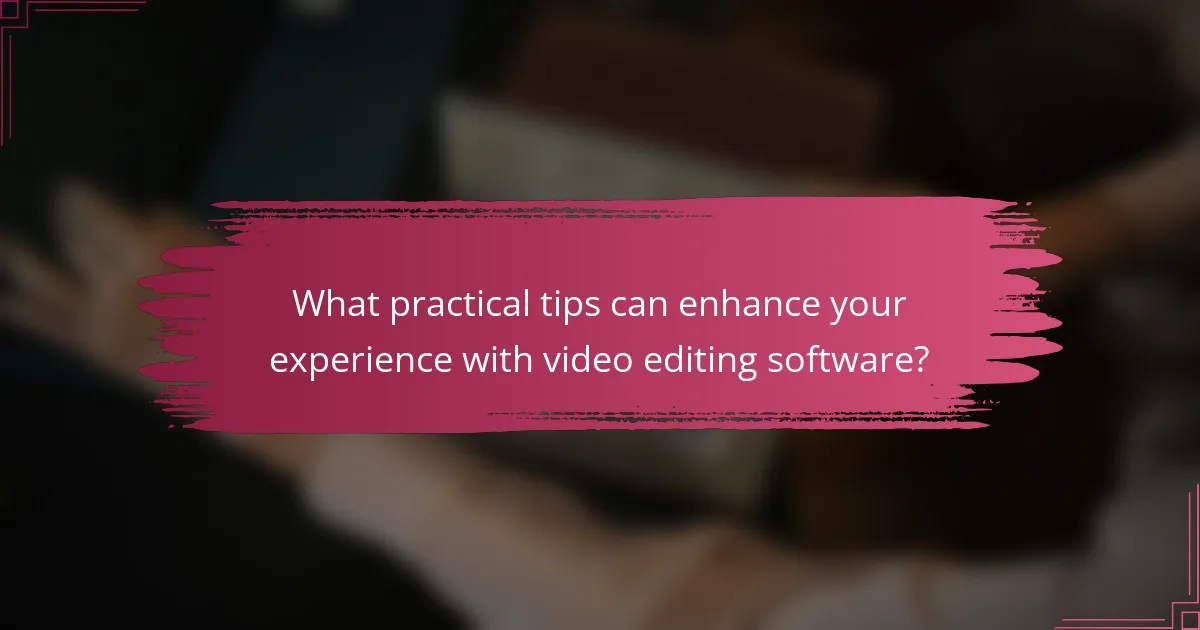
What practical tips can enhance your experience with video editing software?
To enhance your experience with video editing software, familiarize yourself with the interface and tools. Understanding the layout helps streamline your workflow. Utilize keyboard shortcuts to speed up editing tasks. This can significantly reduce the time spent on repetitive actions. Organize your media files in a structured manner. A well-organized project allows for quicker access to assets. Regularly save your work to prevent data loss. Frequent saving is crucial during intensive editing sessions. Experiment with different effects and transitions to find your style. This can improve the overall quality of your projects. Lastly, keep your software updated to access the latest features and improvements. Updated software ensures better performance and stability.
How can you optimize your computer for better editing performance?
Upgrade your computer’s RAM to at least 16GB for better editing performance. More RAM allows for smoother multitasking and faster processing of large files. Consider using a solid-state drive (SSD) instead of a traditional hard drive. SSDs significantly reduce load times and improve overall system responsiveness. Keep your software updated to benefit from performance enhancements and bug fixes.
Adjust your editing software settings to optimize performance. Lowering playback resolution can help in real-time editing. Close unnecessary applications to free up system resources. Use a dedicated graphics card to handle rendering tasks efficiently. A powerful GPU enhances rendering speeds and supports high-resolution video editing. Regularly clean your computer to prevent overheating, which can throttle performance.
What are the best practices for managing video files during editing?
Organize video files into clearly labeled folders. Use a consistent naming convention for files. This simplifies locating specific clips during editing. Backup files regularly to prevent data loss. Utilize external drives or cloud storage for redundancy. Maintain a clear project structure to streamline workflow. Delete unnecessary files to save storage space. Regularly update editing software to ensure compatibility with file formats. These practices enhance efficiency and reduce editing time.
How can shortcuts improve your workflow in video editing software?
Shortcuts can significantly enhance your workflow in video editing software by streamlining repetitive tasks. They allow users to perform actions quickly without navigating through menus. This efficiency reduces the time spent on editing processes. For example, using keyboard shortcuts for cutting, copying, and pasting clips can save several seconds per action. Over the course of a project, this time accumulates to substantial hours saved. Furthermore, shortcuts minimize the risk of errors during editing. They help maintain focus by reducing distractions from mouse movements. Overall, integrating shortcuts into your editing routine can lead to a more efficient and productive workflow.
Top Video Editing Software encompasses various options such as Adobe Premiere Pro, Final Cut Pro, DaVinci Resolve, and Filmora, each with unique features tailored to different user needs. The article outlines key features to consider when choosing video editing software, including user interface, multi-format support, and editing tools. It also discusses system requirements, pricing models, and the impact of hardware specifications on performance. Additionally, the article highlights collaboration features, unique attributes of specific software, and practical tips for optimizing the editing experience.
